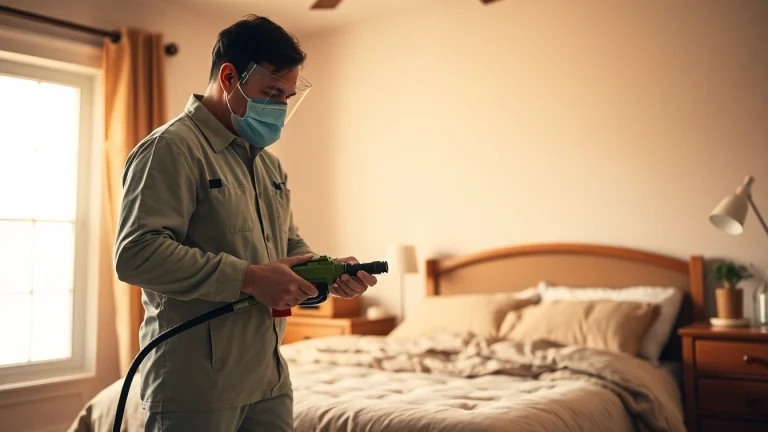
Effective Bed Bug Control Methods: Your Comprehensive Guide to Elimination
Understanding Bed Bugs
What Are Bed Bugs?
Bed bugs, scientifically known as Cimex lectularius, are small, nocturnal insects that feed on the blood of humans and other warm-blooded hosts. They are reddish-brown, flat, and oval-shaped, resembling apple seeds in size and appearance. Adult bed bugs are about 4 to 5 mm in length, while nymphs are smaller and lighter in color. These pests thrive in areas where people rest or sleep, making homes, hotels, and hostels common breeding grounds.
Signs of an Infestation
Detecting a bed bug infestation early is key to effective control measures. Signs include:
- Visible Bugs: Adult bed bugs can often be found in seams of mattresses, bed frames, and furniture.
- Bug Bites: Small, red, and itchy welts on the skin, commonly appearing in lines or clusters.
- Fecal Stains: Dark brown or black spots on bedding and furniture, which are bed bug droppings.
- Egg Casings: Tiny, yellowish shells left behind after bed bugs hatch.
The Life Cycle of Bed Bugs
The life cycle of bed bugs consists of five nymph stages, each requiring a blood meal before molting into the next stage. The entire life cycle—from egg to adult—can take as little as four to five weeks under optimal conditions, allowing infestations to proliferate rapidly if not controlled. Each female bed bug can lay up to 500 eggs in her lifetime, further complicating eradication efforts.
Common Bed Bug Control Techniques
Non-Chemical Control Methods
Non-chemical control methods are vital in managing bed bug infestations, especially in sensitive environments like homes and hotels. Key strategies include:
- Vacuuming: Regular vacuuming of infested areas can physically remove bed bugs and their eggs.
- Steam Cleaning: Using steam at temperatures above 120°F effectively kills bed bugs and their eggs on contact.
- Heat Treatment: Professional heat treatments raise the temperature in infested areas to levels lethal to bed bugs.
- Encasements: Bed bug-proof mattress and box spring encasements prevent bed bugs from entering or escaping.
Chemical Treatments: What to Consider
Chemical treatments can be essential but must be approached with caution. Various pesticide options are available, including:
- Insect Growth Regulators (IGRs): These disrupt the molting process, preventing bed bugs from reproducing.
- Desiccants: Products like diatomaceous earth target the bed bug’s outer waxy coating, leading to dehydration.
- Pyrethroids: Common pesticides that can kill bed bugs on contact but may be less effective on resistant populations.
It is crucial to follow the manufacturer’s instructions carefully and adhere to safety precautions to minimize any risks to human health.
Integrated Pest Management (IPM)
An Integrated Pest Management (IPM) approach combines multiple strategies for effective bed bug control. This includes:
- Monitoring for early detection.
- Utilizing non-chemical treatments alongside careful applications of pesticides.
- Regularly assessing the effectiveness of pest control methods and making adjustments as needed.
IPM emphasizes preventive measures to avoid future infestations and promotes sustainability by reducing dependency on chemical pesticides.
Preparing for Bed Bug Treatment
Assessing Your Space
Before starting treatment, it’s essential to conduct a thorough inspection of your living space. Look for bed bugs in all potential hiding spots, including:
- Mattresses and box springs
- Bed frames and headboards
- Furniture seams and upholstery
- Baseboards, electrical outlets, and light fixtures
If possible, take photos of any signs of infestation for future reference and treatment planning.
Pre-Treatment Checklist
Preparing for bed bug control requires a specific checklist to enhance treatment effectiveness:
- Clear clutter from affected areas, including drawers and shelves.
- Launder bedding, curtains, and clothing in hot water and dry on high heat.
- Vacuum thoroughly before treatment, disposing of the vacuum bag immediately.
Post-Treatment Recommendations
After treatment, monitoring and continued vigilance are crucial. Recommendations include:
- Continue using encasements on mattresses and box springs for at least a year.
- Conduct regular inspections, especially in sleeping areas.
- Be cautious when bringing new items into your home, inspecting them for bed bugs first.
DIY Bed Bug Control Solutions
Home Remedies That Might Work
Several home remedies are often suggested for managing bed bug infestations. While their effectiveness can vary, some options include:
- Essential Oils: Oils such as tea tree, lavender, and peppermint may repel bed bugs, though they likely won’t eliminate infestations entirely.
- Alcohol: Rubbing alcohol can kill bed bugs on contact, but it should be used cautiously due to flammability and effectiveness concerns.
It is important to combine these remedies with other more effective methods to achieve satisfactory results.
Using Commercial Products
Numerous commercial products are designed for DIY bed bug treatments, including sprays, traps, and dusts. Always choose products labeled specifically for bed bugs and check the Environmental Protection Agency’s (EPA) registry for safety and efficacy information. Ensure adherence to all product instructions for safe and effective application.
When to Seek Professional Help
In many cases, professional pest control services are necessary, especially for severe infestations. Consider seeking professional help if:
- You have tried DIY methods without success.
- The infestation is extensive, affecting multiple rooms.
- You are concerned about potential health risks associated with chemical treatments.
Professional exterminators often have access to more potent products and techniques that are not available for consumer use.
Preventing Future Infestations
How to Keep Bed Bugs Away
Prevention is crucial in maintaining a bed bug-free environment. Some effective strategies include:
- Regularly inspect and clean bedding and furniture.
- Seal cracks and crevices around the home.
- Place protective covers on mattresses and box springs.
Being proactive about cleanliness will significantly deter potential infestations.
Best Practices for Travelers
Travelers should be particularly vigilant, as hotels and hostels can be hotspots for bed bugs. Best practices include:
- Inspect hotel rooms before unpacking, focusing on beds, headboards, and furniture.
- Keep luggage off the floor and bed, using luggage racks when available.
- Launder clothing upon returning home, especially if bags were placed on hotel floors.
Long-Term Monitoring Techniques
Implementing long-term monitoring strategies can help catch potential infestations early. Consider:
- Using bed bug monitors, which can alert you to any bed bugs present.
- Conducting regular inspections of high-risk areas.
- Staying informed about bed bug outbreaks in your community.
If you find signs of bed bugs at any time, timely action will help mitigate the problem and prevent a full-blown infestation.
Effective Bed Bug Control is about understanding the pest, employing multiple control methods, and maintaining diligent preventive measures. With a commitment to these principles, controlling bed bug populations and securing a comfortable living space can become a reality.


